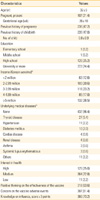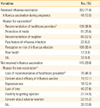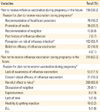Abstract
Purpose
Women who are pregnant, planning to become pregnant in the influenza season or caring for infant 6-59 months of age are identified as priority groups for influenza vaccination. Vaccination rate is presumed to be low in those women. The purpose of this study was to investigate perceptions of childbearing age women about influenza vaccination.
Materials and Methods
Childbearing age women visiting the department of Obstetrics and Gynecology in 3 University hospitals in Seoul and Gyeonggi-do province were surveyed. Individual interviews were performed to them with questionnaire for 2 months from April to May 2012. Demographic data, Immunization history, general understanding and factors associated with vaccination were asked.
Results
Three hundred fifty-five (71.0%) of total 500 reproductive age women had the experience of influenza vaccination. Among 343 women who has been pregnant at least once, 48 women (16.4%) had vaccination during pregnancy, and 46 of them got vaccination since 2009. One hundred ninety women of total 500 women responded that they would get vaccination if pregnant in the next influenza season (38.0%). In multivariate analysis, statistically significant factors associated with plans of influenza vaccination in pregnancy were as follows: experience of childbirth (odds ratio [OR], 1.97; 95% CI, 1.32 to 2.93), high level of education (OR, 1.96; 95% CI, 1.22 to 3.15), previous influenza vaccination (OR, 1.88; 95% CI, 1.17 to 3.01).
Influenza can cause a severe febrile disease and lead to death by itself or its serious complications. Influenza vaccination is the most important method of preventing influenza and recommended to all children more than 6 months of age and adults. It is recommended that people who are classified as high risk group or prone to spread influenza to people identified as high risk group are at the top of the priority list for vaccination [1]. Because pregnant women are likely to be hospitalized for influenza or at increased risk of its complication, such as premature birth or abortion of the fetus, they get priority for influenza vaccination. In addition, women who take care of neonates or infants can spread influenza to high-risk infants are also classified as priority group for influenza vaccination. However, previous studies of maternal influenza immunization rate in Korea is very low, the higher the rates of vaccination showed the higher the mother's perception about influenza vaccination [2]. In 2009, while undergoing an influenza pandemic, the recognition of influenza vaccination for women of childbearing age is expected to improve, but there is no concrete data on this yet. In addition, there is little data evaluating the perception of entire women of childbearing age on influenza vaccination. Therefore, we studied the influenza vaccine-related factors of childbearing age women in Korea.
From April to May 2012, among women visited three university hospital located in Seoul and Gyeonggi-do Province, women who are planning a pregnancy or during medical visits within 6 months of pregnancy or after childbirth were enrolled. Because the maternal influenza vaccination rates of previous studies were 5-12%, we assumed similar vaccination rate and planned survey more than 496 people (level of significance, 0.05; power, 0.8).
More than one trained interviewers by each institution conducted individual interviews with questionnaire in the field. The questionnaire was composed of questions on demographic characteristics, socio-economic indicators, the awareness of efficacy and safety of vaccine, previous influenza vaccination history, factors influencing vaccination and non-vaccination, kinds of factors associated with influenza, knowledge, influenza vaccination plan in pregnancy.
The general characteristics of respondents and the differences of perception were analyzed via chi-square test. Association of influenza vaccination-related factors was analyzed with chi-square test and Fisher's exact test. Multivariate logistic regression analysis was also used. In multivariate analysis, variables statistically significant at the univariate analysis were used. Statistical program SPSS ver. 13.0 (SPSS Inc., Chicago, IL, USA) was used. Knowledge of influenza was scored 0 to 5 points, according to the answers of five questions focused on influenza.
A total of 500 women of reproductive age responded to the survey. The median age of the respondents was 32±6 years. Pregnant women of which were 107 (21.4%) and their median gestational age was 26±10 weeks (Table 1). Among the whole of the respondents, women experienced at least one pregnancy were 236 (37.2%) and if including the current pregnancy, 293 (58.6%) experienced pregnancy. Two hundred thirty-five (47.0%) of all respondents had experienced more than 1 live birth and their average number of children was 1.6±0.6, the average age of first child was 7.6±5.4 years. Three hundred seventy-two (74.4%) of respondents holds an bachelor's degree or more education, and the average monthly income of the family was more than 3 million Korean won (n=334, 66.7%). Sixty-eight (14.6%) of respondents had more than one chronic disease. Thyroid disease was the most common chronic disease (n=27, 39.7%). While 318 (63.6%) of respondents had the usual general positive perception about the effectiveness of the vaccine, 307 (61.4%) concerns about the adverse reactions of the vaccine. Among 5 questions about general knowledge of influenza, 366 (73.2%) scored more than 3 (Supplement 1).
Three hundred fifty-five (71.0%) previously received influenza vaccine at least once. Among them, 48 women were vaccinated with influenza during their pregnancy (Table 2). Among 48 women answered that received influenza vaccination during pregnancy, except 2 who do not remember exactly when, 46 replied it was since 2009. Among the reasons for vaccination, recommendations of healthcare providers (n=138, 38.9%), and the perception on the risk of influenza (n=108, 30.4%) were common. The common reasons why influenza vaccine cannot force the respondents are 1) no recommendation from their healthcare providers (n=70, 48.3%); 2) no time to be vaccinated (n=40, 27.6%).
In univariate analysis, factors associated with influenza vaccination are 1) higher level of education (p=0.02); 2) higher household income (p=0.01); 3) positive perception about the efficacy of the vaccine (p<0.01); and 4) more knowledge about influenza (p<0.01) (Table 3). However, concern about aggravation of the underlying disease or adverse reactions between the two groups showed no statistically significant difference. In multivariate analysis, 1) positive perception about the efficacy of the vaccine (odds ratio [OR], 2.37; 95% confidence interval [CI], 1.56 to 3.60) and 2) more knowledge about influenza (OR, 2.78; 95% CI, 1.80 to 4.30) were significantly associated with acceptance of influenza vaccination (p=0.01).
One hundred ninety of respondents (38.0%) responded that they were going to receive influenza vaccination during pregnancy in the future (Table 3). Among them, 102 (53.7%) decided to receive influenza vaccine because of the risk of influenza and 76 (40.0%) decided to receive influenza vaccine according to the recommendations of healthcare providers. The most important factor attributed to the future vaccination during pregnancy is the risk of influenza infection (n=82, 43.2%). Concerning about influenza vaccination during pregnancy, the leading causes of non-vaccination are that the vaccine may be harmful to the fetus (n=260, 83.9%) and that they did not see or hear about influenza vaccine (n=53, 17.1%). In univariate analysis, the group planning influenza vaccination during pregnancy had more experience of childbirth (p<0.01), higher levels of education (p<0.01), positive thinking about the effectiveness of vaccination (p<0.01), more accurate knowledge (p<0.01), and more frequent past history of influenza vaccination (p<0.01) than those who are not planning. In multivariate analysis, statistically significant factors associated with plans of influenza vaccination in pregnancy were as follows: experience of childbirth (OR, 1.97; 95% CI, 1.32 to 2.93), high level of education (OR, 1.96; 95% CI, 1.22 to 3.15), previous influenza vaccination (OR, 1.88; 95% CI, 1.17 to 3.01).
Compared with healthy non-pregnant women, pregnant women infected with influenza virus are more likely to be hospitalized. And their risk of complication or death caused by influenza is high [3,4]. In addition, Influenza during pregnancy increases the risk of premature birth or stillbirth [5-7]. The factors suggested to increase the susceptibility of complicated influenza during pregnancy are linked to the physiologic changes that occur during pregnancy (most pronounced in the third trimester), including immunologic changes, increased cardiac output and oxygen consumption, decreased lung capacity and tidal volume [8]. In 2009, pregnant women infected with influenza A (H1N1) pdm09 had severe illness and high risk of mortality [9-11]. In contrast, the lack of harmful effects of inactivated influenza vaccination on both maternal and fetal health during pregnancy has been demonstrated in several studies. No differences in gestational age, proportion with cesarean delivery, birth weight, or length of stay for birth hospitalization were reported. Rather, it is suggested that maternal influenza vaccination can reduce small for gestational age birth [12-17]. Also, produced maternal antibodies are delivered through the placenta to the fetus to acquire passive immunity. The duration of passively acquired antibody of infants depends on the initial cord blood concentration, and it is probably less than 6 months. Thus maternal immunization during pregnancy can protect pregnant women from influenza as well as their neonates and young infants [12]. Therefore, inactivated influenza vaccination is strongly recommend for pregnant women or childbearing age women scheduled to be pregnant for an influenza pandemic [1,18]. But seasonal influenza vaccination rate of them is low in Korea. Kim et al. [2] reported that the seasonal influenza vaccination rate among the Korean pregnant women was only 4% during 2006-2007 influenza epidemic season.
The results of this study, the childbearing age women who have influenza vaccination at least once were 71% of entire respondents, did not differ with past study during 2006-2007 season. But this study showed the influenza vaccination rate during pregnancy of women pregnant who are now or has been at least once in the past was 16.4%, higher than 4% of those of past study. The improved vaccination rate during pregnancy in this study (16.4%) is explained by accumulation of past vaccinations for several influenza epidemic seasons. In the past study, a one season's influenza vaccination rate (4%) has been evaluated. However, the majority of respondents who have received influenza vaccine during pregnancy got vaccination since 2009. It means actual increased influenza vaccination rate of pregnant women due to improved level of public awareness and knowledge about influenza by nationwide promotion undergoing influenza A(H1N1) pdm09. In this study, 38.0% of all participants responded that they had a plan to receive influenza vaccination during pregnancy in the future. Influenza vaccination rate of pregnant women is expected to increase in the future.
Although influenza vaccination rate of pregnant women increased, it is still much lower than that of elderly 65 years old or more (77-79%) and healthy adults (30%), even compared with influenza vaccination rate of American pregnant women [19-21]. Most important factor associated with low influenza vaccination rate of pregnant women was lack of recommendation of healthcare providers. In this study, recommendation of healthcare providers is main determining factor for Korean childbearing age women. And 61.4% of all respondents had a concern about adverse reaction of general vaccines. Eighty-three point nine percent of respondents who are not planning influenza vaccination during pregnancy responded that they had a concern about harmful effect to their fetus. Additionally, 44.2% of entire respondents misunderstood that influenza vaccination of pregnant women was harmful to fetus. These results suggest that the concerns about safety of influenza vaccine are the major obstacles to increase vaccination rate of pregnant women. To improve influenza vaccination rate of pregnant women, it is important that healthcare providers explain and recommend influenza vaccination exactly and actively.
In multivariate analysis on factors associated with influenza vaccination, statistically significant factors were accurate understandings about influenza and positive roles of general vaccines. The results suggest that active education and promotion of influenza and vaccine can increase influenza vaccination rate. High income and high level of education have correlation with high vaccination rate in univariate analysis, but no significant correlation in multivariate analysis. However, 12.4% of non-vaccination group responded that the reason why did not receive influenza vaccination was expense of influenza vaccine. Thus, free vaccination for priority groups of influenza vaccination should be considered according to the economic level.
In multivariate analysis on factors associated with planning vaccination during pregnancy, significant variables are experience of childbirth, high level of education, previous influenza vaccination. Women who have experience of childbirth get more chance to exposure to medical information. And direct experience of efficacy and safety of influenza vaccination would lead to high vaccination rate during pregnancy.
In this study, the participants were not limited to pregnant women but childbearing age women including pregnant women. Influenza vaccination is highly recommended for not only pregnant women but also women planning to become pregnant and caring for neonates and infants.
Limitations of this study were as follows; first, the participants do not represent the whole childbearing age women as visitors to the university hospital were recruited. Second, vaccination history could be inaccurate because it was based on interview without confirmation by medical record.
In conclusion, influenza vaccination rate during pregnancy has been a slight improvement since 2009 but is still very low. To improve vaccination rate of childbearing age women including pregnant women, important factors are accurate education of efficacy and safety of influenza vaccine and strong recommendation of healthcare provider.
Figures and Tables
References
1. Cheong HJ. Korean Society of Infectious Diseases. Influenza. Vaccination for adult. 2012. 2nd ed. Seoul: MIP;133–151.
2. Kim MJ, Lee SY, Lee KS, et al. Influenza vaccine coverage rate and related factors on pregnant women. Infect Chemother. 2009. 41:349–354.

3. Jamieson DJ, Theiler RN, Rasmussen SA. Emerging infections and pregnancy. Emerg Infect Dis. 2006. 12:1638–1643.

4. Cono J, Cragan JD, Jamieson DJ, Rasmussen SA. Prophylaxis and treatment of pregnant women for emerging infections and bioterrorism emergencies. Emerg Infect Dis. 2006. 12:1631–1637.

5. Stanwell-Smith R, Parker AM, Chakraverty P, Soltanpoor N, Simpson CN. Possible association of influenza A with fetal loss: investigation of a cluster of spontaneous abortions and stillbirths. Commun Dis Rep CDR Rev. 1994. 4:R28–R32.
6. Naleway AL, Smith WJ, Mullooly JP. Delivering influenza vaccine to pregnant women. Epidemiol Rev. 2006. 28:47–53.

7. Rasmussen SA, Jamieson DJ, Bresee JS. Pandemic influenza and pregnant women. Emerg Infect Dis. 2008. 14:95–100.

8. Lim WS, Macfarlane JT, Colthorpe CL. Treatment of community-acquired lower respiratory tract infections during pregnancy. Am J Respir Med. 2003. 2:221–233.

9. Brown CM. Severe influenza A virus (H1N1) infection in pregnancy. Obstet Gynecol. 2010. 115(2 Pt 2):412–414.

10. Hewagama S, Walker SP, Stuart RL, et al. 2009 H1N1 influenza A and pregnancy outcomes in Victoria, Australia. Clin Infect Dis. 2010. 50:686–690.

11. Centers for Disease Control and Prevention (CDC). 2009 pandemic influenza A (H1N1) in pregnant women requiring intensive care: New York City, 2009. MMWR Morb Mortal Wkly Rep. 2010. 59:321–326.
12. Blanchard-Rohner G, Siegrist CA. Vaccination during pregnancy to protect infants against influenza: why and why not? Vaccine. 2011. 29:7542–7550.

13. Munoz FM, Greisinger AJ, Wehmanen OA, et al. Safety of influenza vaccination during pregnancy. Am J Obstet Gynecol. 2005. 192:1098–1106.

14. Zaman K, Roy E, Arifeen SE, et al. Effectiveness of maternal influenza immunization in mothers and infants. N Engl J Med. 2008. 359:1555–1564.

15. Englund JA. Maternal immunization with inactivated influenza vaccine: rationale and experience. Vaccine. 2003. 21:3460–3464.

16. Steinhoff MC, Omer SB, Roy E, et al. Neonatal outcomes after influenza immunization during pregnancy: a randomized controlled trial. CMAJ. 2012. 184:645–653.

17. Omer SB, Goodman D, Steinhoff MC, et al. Maternal influenza immunization and reduced likelihood of prematurity and small for gestational age births: a retrospective cohort study. PLoS Med. 2011. 8:e1000441.

18. Advisory Committee on Immunization Practices. Recommended adult immunization schedule: United States, 2012. Ann Intern Med. 2012. 156:211–217.
19. Kee SY, Lee JS, Cheong HJ, et al. Influenza vaccine coverage rates and perceptions on vaccination in South Korea. J Infect. 2007. 55:273–281.





 PDF
PDF ePub
ePub Citation
Citation Print
Print





 XML Download
XML Download